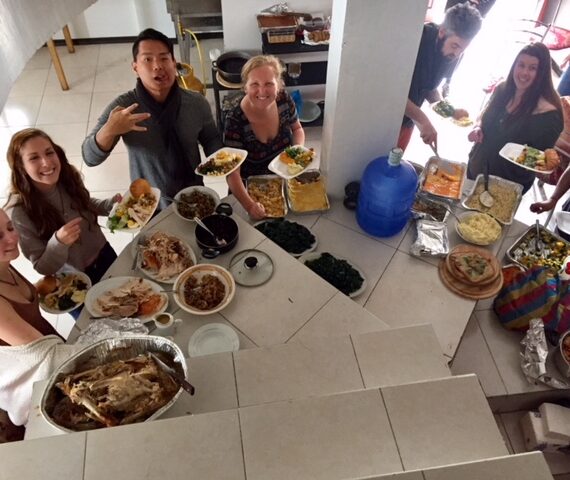
Guest Blog Post by Allison Dawson
When browsing through my Aunt Becky’s list of possible destinations to visit, I was admittedly a little overwhelmed by all the options. My mom and I were headed to Ecuador for a two-week trip and I was ready for any and every experience that would give me a glimpse into life within Ecuador, especially its natural beauty and native customs. Next to a little asterisk warning “not for the faint of heart”, was the option for an overnight stay in an ecological reserve in the cloud forest of Intag Valley. After some Googling, I was hooked. With this travel option, we would be staying in a community called El Rosal.

Greeted with open arms and genuine smiles, Germania and the women of El Rosal showed us to our rooms. Expecting a home-stay environment, we were surprised by a freshly built hostal – an amenity quite unexpected this far out in el campo. Outside my bedroom window was a tangle of flowers and greenery, attracting all types of colorful hummingbirds.
 |
| My mother, Julie, and I in El Rosal |
Franklin continued to show us around this hilltop agricultural community, introducing us to their pigs, their bio-gas collection pit (from what we could tell, they run completely on bio-gas from animal excrement and food waste…so cool!), their cuy pens, their various fruit trees and gardens, and finally their aquaculture ponds. Being a bit of a fish nerd myself, I was super interested to see the simplicity of their systems and witness sustainability in action. Watching them cast-net and select the largest and juiciest tilapia to sell/trade with their neighbors put a grin on my face, despite how tired I still was from traveling.
I thought to myself, they had said something after lunch about having freshly made coffee…
I wonder when that will be?
 My questions were answered when we returned to the dining area and kitchen. Cooking over an open wood cooker was a large pot of freshly peeled green coffee beans. They weren’t kidding when they said fresh! I took a couple turns at constantly stirring the beans so they didn’t burn, but the locals had to keep spelling me and then each other. Stirring beans is a surprisingly tiring exercise that lasts a good 3 hours at least for a quality roast. During this time, I learned how the men of this community work together to cultivate and harvest their coffee beans, selling them to a larger co-op of coffee growers from the Intag Valley, which then distribute their green beans all over the world.
My questions were answered when we returned to the dining area and kitchen. Cooking over an open wood cooker was a large pot of freshly peeled green coffee beans. They weren’t kidding when they said fresh! I took a couple turns at constantly stirring the beans so they didn’t burn, but the locals had to keep spelling me and then each other. Stirring beans is a surprisingly tiring exercise that lasts a good 3 hours at least for a quality roast. During this time, I learned how the men of this community work together to cultivate and harvest their coffee beans, selling them to a larger co-op of coffee growers from the Intag Valley, which then distribute their green beans all over the world. While we stepped outside the kitchen and took turns hand grinding the coffee beans to powder, Germania and Maria began to cook the Pan de Yuca. Germania decided to cook the bread in a special manner for a “different flavor”. First, she placed the formed bread rolls into a large metal pot and placed that over a small wood fire. A jumble of burning branches were then loaded on top of its metal lid. I don’t know if it was this type of “dutch-oven” cooking method or the pig fat in the bread, but it was the most amazing bread I have ever had the pleasure to eat. To be honest, I forget what else was for dinner besides that amazing Pan de Yuca and fresh field-to-table coffee.
The following morning we woke and enjoyed another amazing breakfast of cheese empanadas. The coffee we ground the night before somehow tasted even better the second time around. After breakfast, we finally got a glimpse of the soap laboratory that put this community cooperative on the map. Originally, it was the ladies of this community who learned how to cultivate and harvest aloe-vera, making an all-natural soap to sell. With a newly-built laboratory, they also make shampoo and lotions, distributing these through vendors in other countries. Of course, we had to buy some to share! Then just like that, it was time for us to load up in a taxi and continue on our Ecuador adventures.
and their Facebook Page: Finca Agroecológica El Rosal
Before we left, we introduced them to various travel and experience accommodation web sites such as Booking.Com and Airbnb. I hope they expand their online presence so more people like me can experience this interesting and beautiful community. I’d give this eco-tourism lodge a 5-star rating for sure!

















Allison
Thank you for giving me the opportunity to write about such an awesome experience. We love you, El Rosal!